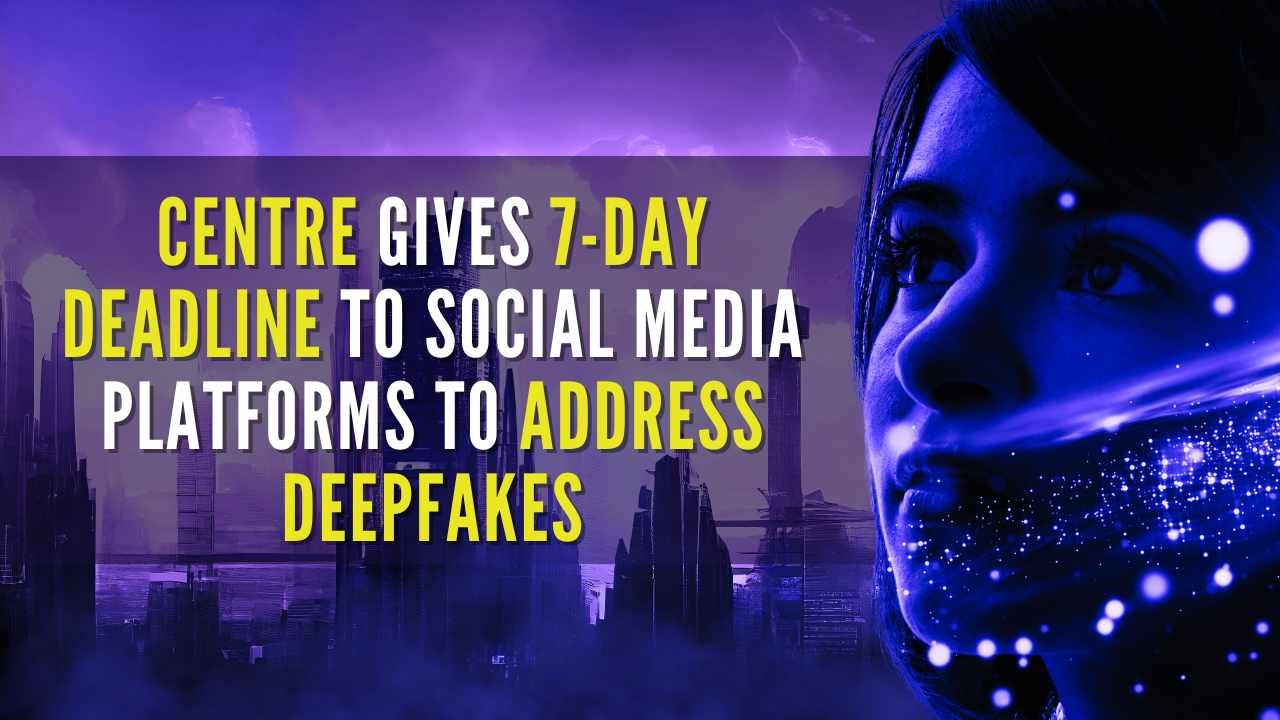MeitY Takes Action Against Deepfakes: Social Media Massive companies Have Seven Days to Help Users File FIRs
The Ministry of Electronics and Information Technology (MeitY) in India has sent a strong instruction to social media sites in an effort to address the increasing risk of deep fake content. Major internet platforms have been given a strict 7-day deadline by the ministry to help individuals who are the targets of deepfake attacks file First Information Reports (FIRs).
The problem with The fake
A combination of “deep learning” and “fake,” deep fakes are artificial intelligence-produced, amazingly lifelike altered movies and audio recordings. These dishonest works of art can be employed for a number of criminal activities, such as character assassination, identity theft, and the spread of false information.
Governments and tech companies have responded to concerns raised by the growing extent of deepfake technology worldwide. India has been especially careful in tackling the possible risks posed by deepfakes because of its large number of internet users.
MeitY’s Appeal to the Big Social Media Companies
It is evident from the Ministry of Electronics and Information Technology’s statements that social media companies should take an active approach to stopping the spread of deep fakes and providing assistance to individuals who are impacted by them. set the seriousness of the situation, these platforms have been set a 7-day deadline to ensure a prompt response to deepfake events.
Helping Disappointed Users
The focus placed by MeitY’s direction on helping unhappy users file FIRs is one of its main features. One of the most important steps in bringing legal action against the people behind the creation and sale of deep fake content is providing a First Information Report.
Social media companies will have to give people who think they’ve been the target of deepfake attacks the support and direction they need. This involves offering users with precise instructions on how to report events, protecting evidence, and helping them with the procedures necessary to officially file a complaint with law authorities.
What is the reason for the urgency?
MeitY’s directive is necessary since deepfake content has the potential to cause harm. Effective deep fake campaigns can have serious effects, such as damaging reputations and changing public opinion. The government intends to guarantee that victims receive timely aid and that the inquiry process starts without needless delays by setting a strict 7-day timeframe.
The Responsibility of Social Media Platforms
Giants in social media have a significant impact on how the internet is shaped. These platforms have become sites for the spread of information, both real and fake, with millions of users interacting with content every day. MeitY’s requirements highlight how accountable these platforms are for making sure their user base is safe and secure.
Social media companies should not only let people file FIRs but also employ cutting-edge tools to quickly identify and remove deep fake content. This proactive strategy is essential to stopping the swift spread of false information before it may do serious harm.
Campaigns for Public Awareness
MeitY is thinking of starting public awareness efforts to inform people about the dangers of deep lakes in addition to the rules and regulations. With the help of these efforts, consumers should be more aware of the content they come across online and be equipped to see and report any instances of influence.
Effective deepfake prevention requires a plan that includes raising awareness and educating people. Through educating the public about these kinds of false technology and their possible effects, the government aims to strengthen the fabric of the online community.
The World Vision
India’s action against the deepfake threat is in line with global efforts to confront this expanding danger. Globally, governments and tech businesses are allocating resources towards research and technology in order to create effective instruments for identifying and reducing the effects of deep fakes.
Working together, governments and tech companies can combat deep fakes, which are incorrect works of art that frequently cross national borders. The international community may cooperate to keep one step ahead of those looking to take advantage of fake technology by sharing information and resources.
Obstacles coming up
Although MeitY’s instruction is a big start in the right direction, there are still obstacles in the way of these actions being carried out successfully. Social media companies face an ongoing challenge as a result of the quick development of deepfake technology, which necessitates frequent modifications to detection systems.
Furthermore, the legal structure related to deepfakes must be strong and flexible in order to keep up with the constantly evolving risks that arise online. To provide prevention, it is essential to provide clear guidelines about punishments for producing and sharing deep fake content.
Continued Partnership for a Safe Digital Future
No one organisation can win the fight against deep fakes on its own. The Ministry of Electronics and Information Technology encourages cooperation between the government, law enforcement, and social media companies in accepting this. To guarantee a concerted effort in recognising and fighting deepface dangers, ongoing discussions and information-sharing platforms are being established.
To stay ahead of the curve, the government also strongly requests feedback from academics, researchers, and technology professionals. India hopes to establish a complete defence against these digital changes by enlisting a varied variety of stakeholders in response to the dynamic nature of deepfake technology, which calls for a fluid and adaptable strategy.
Building Electronic Boundaries
Apart from setting deadlines on social media sites, MeitY places resources towards the creation and implementation of advanced technology intended to detect and fight deepface content. To use AI for the benefit of society as a whole, partnerships with academic institutions and tech firms are being formed.
These technical protections are essential for both finding and eliminating deep fake content that has already surfaced and for being ahead of new dangers. In order to continuously improve detection methods, deepface generation patterns and behaviours are being analysed using machine learning algorithms, neural networks, and other cutting-edge technology.
Implications for the Law and The loss
Avoiding individuals involved in the creation and distribution of deepfake content requires not just technology solutions but also a strong legal framework. In order to explicitly address the issues raised by deep fakes, MeitY is working to improve current rules and introduce new regulations.
The government wants to create a deterrent that prevents anyone from engaging in evil deepface operations by outlining the punishments that would apply to those who do so. Law enforcement efforts coupled with severe punishments will effectively communicate to the public that acts related to deepfake will not be tolerated.
User Empowerment by Training
MeitY is strongly focusing on user empowerment and education as part of a larger plan. The government’s planned education programmes will not only draw attention to the dangers of deep fakes, but will also give users useful tools for identifying and noting inappropriate materials.
The goal of educational activities is to create a more intelligent online community that is prepared to properly travel the digital terrain. Users will be asked to assess content authenticity critically, particularly when it comes to delicate or controversial topics.
Global Teamwork for an International Solution
India is actively participating in international cooperation because it understands that deep fake threats pass national boundaries. Sharing knowledge, best practises, and technical advancements with other countries will strengthen the world’s defence against deepfakes.
Defined methods for preventing deep fake threats can be developed through worldwide coordination of efforts. Countries can work together to reduce the global impact of these misleading technologies by combining resources and linking policies.
The Path Ahead: A More Secure Digital Environment
The path ahead will probably be defined by constant growth and change as MeitY takes action to address the deepfake issue. Fighting deepfakes requires a constant commitment to staying one step ahead of those looking to take advantage of technological defects rather than a one-time effort.
It is important that users play a significant part in creating a safer digital environment. People can help the group protect against deepface dangers by being aware, applying best practices, and being watchful. Our methods for preserving the correctness of online data must develop together with technology.
In summary, MeitY’s instruction to social media companies is an important step in the fight over deep fakes. The government has demonstrated an in-depth understanding of the issues posed by deepfake technology through its multidimensional strategy, which includes technological innovation, law strengthening, user education, and international collaboration. The fact that India is leading the way makes it very clear that everyone must benefit from the security of the digital sphere, and that governments, IT companies, and consumers must work together to achieve this.






